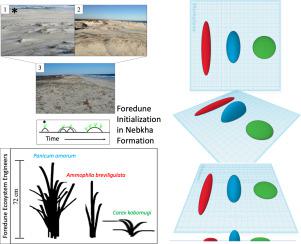Geomorphology ( IF 3.1 ) Pub Date : 2021-01-06 , DOI: 10.1016/j.geomorph.2021.107594 Bianca Reo Charbonneau , Stephanie M. Dohner , John P. Wnek , Don Barber , Phoebe Zarnetske , Brenda B. Casper

|
As the land-sea interface, foredunes buffer upland habitats with plants acting as ecosystem engineers shaping topography, and thereby, affecting storm response and recovery. However, many ecogeomorphic feedbacks in coastal foredune formation and recovery remain uncertain in this dynamic environment. We carried out a series of wind tunnel experiments testing how the morphology, density, and configuration of three foredune pioneer dune builder species influence the most basic stage of dune initiation — nebkha formation around individual plants. We established monocultures of native Ammophila breviligulata and Panicum amarum and invasive Carex kobomugi in 1m x 1m planter boxes of sand to simulate approximate natural and managed densities and planting configurations on the US Mid-Atlantic coast. We subjected each box to constant 8.25 m/s wind for 30-minutes in a moveable-bed unilateral-flow wind tunnel with an unvegetated upwind sand bed. We quantified resulting topography with sub-millimeter precision and related it to plant morphology, density, and configuration. Plant morphology, density, and configuration all influenced the resulting topography. Larger plants produced larger nebkha with greater relief, height, and sand volume. However, nebkha area, height, and planform shape varied among species, and taller plants did not necessarily produce taller nebkha. The erect grasses, Ammophila and Panicum, produced more elongated, high-relief nebkha compared to the low-lying Carex, which produced lower and more symmetrical nebkha. A staggered planting configuration produced greater net sediment accumulation than non-staggered. We validated these results against high-resolution field topographies of foredune nebkha and found strong agreement between the datasets. Our results provide species-specific parameters useful in designing foredune plantings and beach management and can be used to parameterize vegetation in models of foredune evolution associated with different plant species. By first understanding the underlying ecogeomorphic feedbacks involved in nebkha formation, we can more effectively scale up to forecast coastal foredune evolution and recovery.
中文翻译:

植被对沿海甲壳类植物萌发的影响:三座沙丘建筑工厂的风洞实验和田间验证
作为陆地与海洋的界面,前兆利用植物作为生态系统工程师来塑造地形来缓冲高地栖息地,从而影响风暴的响应和恢复。然而,在这种动态环境下,沿海前陆形成和恢复过程中的许多生态地貌反馈仍然不确定。我们进行了一系列风洞实验,测试了3种Foredune先锋沙丘建造者物种的形态,密度和配置如何影响沙丘萌芽的最基本阶段-单个植物周围的nebkha形成。我们建立了本地短杆菌Amophila breviligulata和Panicum amarum以及侵入性Carex kobomugi的单一培养物在1m x 1m的种植箱中放进沙子,以模拟美国中大西洋沿岸的近似自然密度和管理密度以及种植配置。我们在一个装有无植被上风沙床的可移动床单向风洞中,对每个箱子施加8.25 m / s的恒定风速30分钟。我们以亚毫米级的精度对得到的地形进行了量化,并将其与植物的形态,密度和配置相关联。植物的形态,密度和配置都影响了最终的地形。较大的植物产生较大的nebkha,其浮雕,高度和沙量更大。但是,nebkha的面积,高度和平面形状因物种而异,并且较高的植物不一定产生较高的nebkha。直立的草,Ammophila和Panicum与低洼的Carex相比,它产生的拉长的,高浮雕的nebkha较矮的Carex产生的低而对称的nebkha。交错种植结构比非交错种植产生更大的净沉积物积累。我们针对foredune nebkha的高分辨率野外地形验证了这些结果,并发现数据集之间的强烈一致性。我们的结果提供了特定物种的参数,这些参数可用于设计山茱plant种植和海滩管理,并可用于参数化与不同植物物种相关的山茱evolution进化模型中的植被。通过首先了解与nebkha形成有关的潜在生态地貌反馈,我们可以更有效地扩大规模,以预测沿海前陆的演化和恢复。











































 京公网安备 11010802027423号
京公网安备 11010802027423号